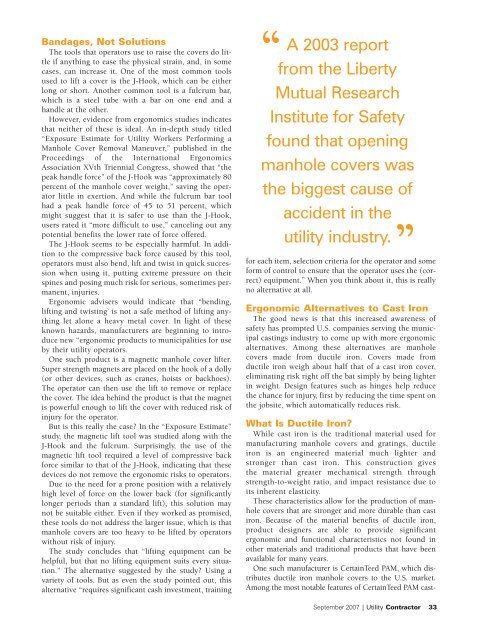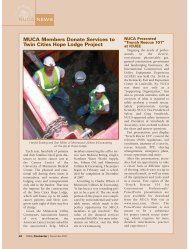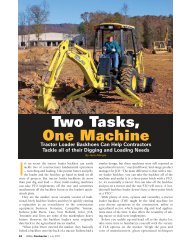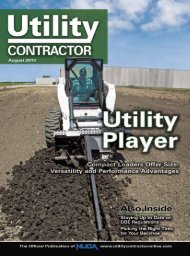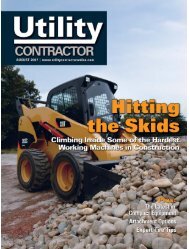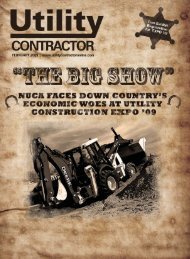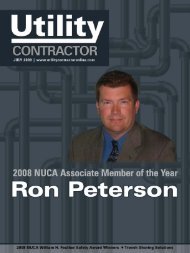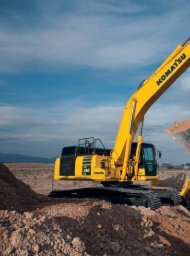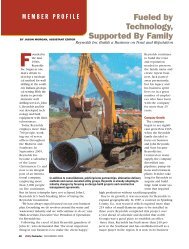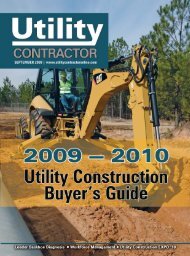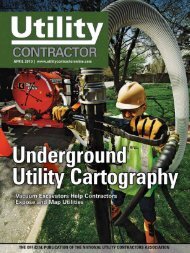View Full September PDF Issue - Utility Contractor Online
View Full September PDF Issue - Utility Contractor Online
View Full September PDF Issue - Utility Contractor Online
Create successful ePaper yourself
Turn your PDF publications into a flip-book with our unique Google optimized e-Paper software.
Bandages, Not SolutionsThe tools that operators use to raise the covers do littleif anything to ease the physical strain, and, in somecases, can increase it. One of the most common toolsused to lift a cover is the J-Hook, which can be eitherlong or short. Another common tool is a fulcrum bar,which is a steel tube with a bar on one end and ahandle at the other.However, evidence from ergonomics studies indicatesthat neither of these is ideal. An in-depth study titled“Exposure Estimate for <strong>Utility</strong> Workers Performing aManhole Cover Removal Maneuver,” published in theProceedings of the International ErgonomicsAssociation XVth Triennial Congress, showed that “thepeak handle force” of the J-Hook was “approximately 80percent of the manhole cover weight,” saving the operatorlittle in exertion. And while the fulcrum bar toolhad a peak handle force of 45 to 51 percent, whichmight suggest that it is safer to use than the J-Hook,users rated it “more difficult to use,” canceling out anypotential benefits the lower rate of force offered.The J-Hook seems to be especially harmful. In additionto the compressive back force caused by this tool,operators must also bend, lift and twist in quick successionwhen using it, putting extreme pressure on theirspines and posing much risk for serious, sometimes permanent,injuries.Ergonomic advisers would indicate that “bending,lifting and twisting’ is not a safe method of lifting anythinglet alone a heavy metal cover. In light of theseknown hazards, manufacturers are beginning to introducenew “ergonomic products to municipalities for useby their utility operators.One such product is a magnetic manhole cover lifter.Super strength magnets are placed on the hook of a dolly(or other devices, such as cranes, hoists or backhoes).The operator can then use the lift to remove or replacethe cover. The idea behind the product is that the magnetis powerful enough to lift the cover with reduced risk ofinjury for the operator.But is this really the case? In the “Exposure Estimate”study, the magnetic lift tool was studied along with theJ-Hook and the fulcrum. Surprisingly, the use of themagnetic lift tool required a level of compressive backforce similar to that of the J-Hook, indicating that thesedevices do not remove the ergonomic risks to operators.Due to the need for a prone position with a relativelyhigh level of force on the lower back (for significantlylonger periods than a standard lift), this solution maynot be suitable either. Even if they worked as promised,these tools do not address the larger issue, which is thatmanhole covers are too heavy to be lifted by operatorswithout risk of injury.The study concludes that “lifting equipment can behelpful, but that no lifting equipment suits every situation.”The alternative suggested by the study? Using avariety of tools. But as even the study pointed out, thisalternative “requires significant cash investment, training“A 2003 reportfrom the LibertyMutual ResearchInstitute for Safetyfound that openingmanhole covers wasthe biggest cause ofaccident in theutility industry. ”for each item, selection criteria for the operator and someform of control to ensure that the operator uses the (correct)equipment.” When you think about it, this is reallyno alternative at all.Ergonomic Alternatives to Cast IronThe good news is that this increased awareness ofsafety has prompted U.S. companies serving the municipalcastings industry to come up with more ergonomicalternatives. Among these alternatives are manholecovers made from ductile iron. Covers made fromductile iron weigh about half that of a cast iron cover,eliminating risk right off the bat simply by being lighterin weight. Design features such as hinges help reducethe chance for injury, first by reducing the time spent onthe jobsite, which automatically reduces risk.What Is Ductile Iron?While cast iron is the traditional material used formanufacturing manhole covers and gratings, ductileiron is an engineered material much lighter andstronger than cast iron. This construction givesthe material greater mechanical strength throughstrength-to-weight ratio, and impact resistance due toits inherent elasticity.These characteristics allow for the production of manholecovers that are stronger and more durable than castiron. Because of the material benefits of ductile iron,product designers are able to provide significantergonomic and functional characteristics not found inother materials and traditional products that have beenavailable for many years.One such manufacturer is CertainTeed PAM, which distributesductile iron manhole covers to the U.S. market.Among the most notable features of CertainTeed PAM cast-<strong>September</strong> 2007 | <strong>Utility</strong> <strong>Contractor</strong> 33


